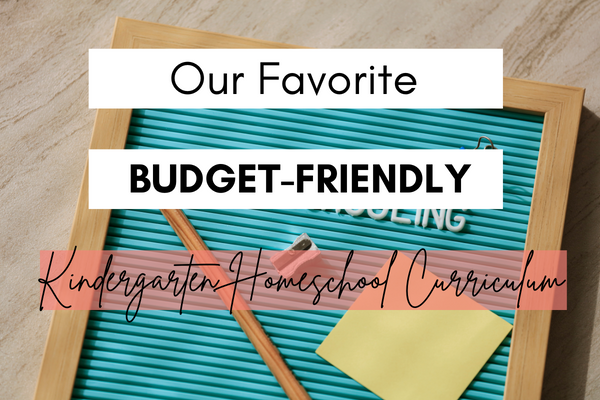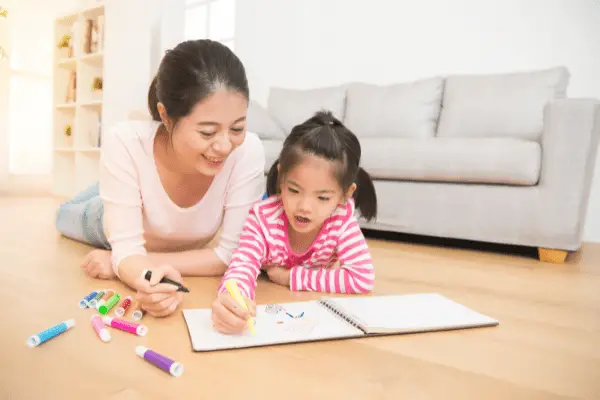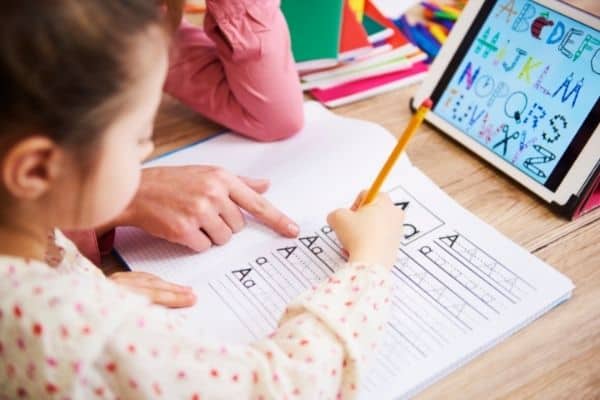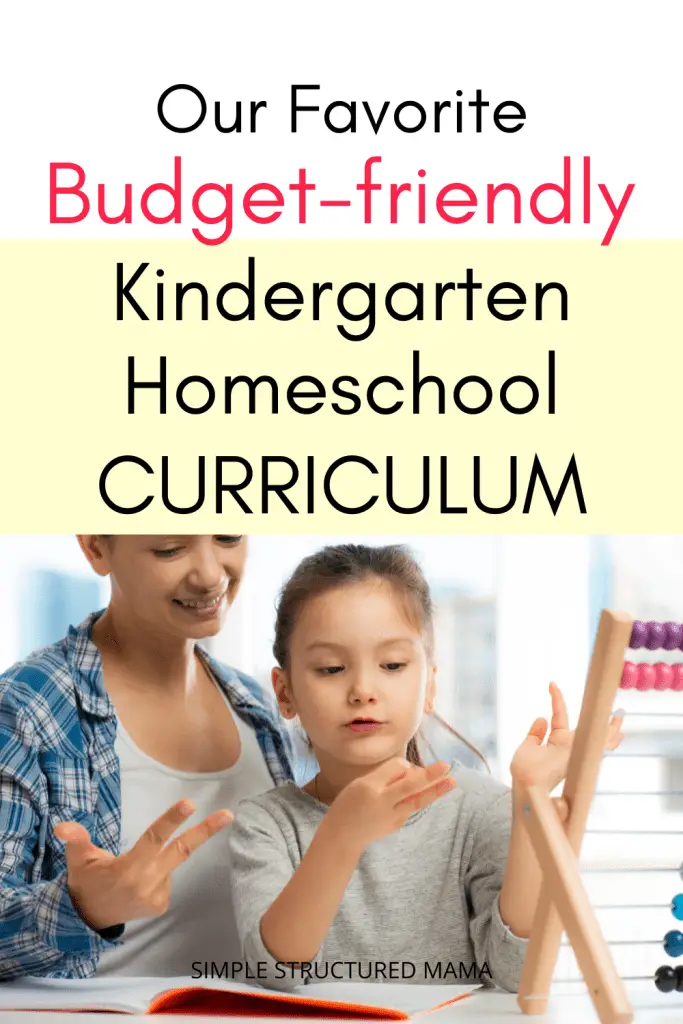
You may find affiliate links throughout this post. Read my full disclosure here.
Looking for a good kindergarten homeschool curriculum?
Choosing the best one can feel like you’re trying to choose the best flavor of ice cream in the ice cream aisle-there are just so many good options!
Some programs boast colorful, eye-catching workbooks, while others have crafts and art projects that look like they could turn your little one into the next Picasso.
You may have found yourself wondering which one is the best one and if there’s really a difference between going with a cheaper curriculum or a more expensive one.
I’ve homeschooled kindergarten four different times and have used slightly different curricula for each. My oldest two girls, who at one point had to go to a charter school for a year and a half, ended up testing above their grade level academically and thrived in school.
I say this to let you know that the resources I’m suggesting for kindergarten curriculum aren’t just random-I’ve actually used them and they’ve contributed to my children’s academic success and high reading levels. I think you’ll also appreciate these suggestions, as they’re easy on your budget!
In this post, I want to talk to you about our family’s favorite simple-yet-thorough kindergarten homeschool curriculum to hopefully help you choose your own.
What should you teach in kindergarten homeschool?
Let’s first start with what our kids need to learn in kindergarten.
I’ve found that unless a mom is seasoned in homeschooling, she typically wants to make sure she’s covering all the bases. She doesn’t want her child “falling through gaps” and wants to make sure her child is at least learning the things he or she would learn in a traditional kindergarten school setting.
In kindergarten, your child is 4-6 years old and would typically learn the following things:
Math
- Number identification
- Counting & skip counting
- Basic addition & subtraction
- Days of the week and months of the year
- Intro to time
- Patterns & grouping
- Shape identification
English Language Arts
- Letter identification/sounds (unless already learned)
- Phonics
- Sight words
- Reading
Handwriting
Your child will learn how to make basic lines in all directions, as well as the correct formation of letters and numbers.
Arts, crafts, and other projects
No kindergarten program would be complete without letting your little one’s creative side out. Many curricula will include creative projects, but if they don’t and you want your little one to do some of the seasonal projects kids do in school, Pinterest is a great place to find ideas!
Science
Some curricula offer lessons in science & social studies that cover basic concepts such as seasons, weather, animal studies, etc. These can be easily added to any curriculum by simply checking out books from your local library and reading to your child.
Most curricula out there will have some or all of these components. Thus, even if you choose to go with a less expensive one, it’s likely to “cover all the bases” you’d typically be concerned about.
What else your kindergarten homeschoolers need
As much as you want to find the best kindergarten homeschool curriculum for your child, in the grand scheme of things, academic education is not the only important thing to focus on when it comes to homeschooling.
Aside from a kindergarten homeschool curriculum, your kiddos need a few other important things: habits, life skills, active play, and of lots of connection with you.
Habits
Education at any age goes far beyond just filling our kids’ minds with information and covering basics-it involves shaping their character by building habits. In fact, Webster’s 1828 Dictionary defines education like this:
“[the] series of instruction and discipline which is intended to enlighten the understanding, correct the temper, and form the manner and habits of youth, and fit them for usefulness in their future stations.”
webster’s 1828 dictionary
Teaching our kids how to make their beds every morning, take their plates to the sink after eating, wash their hands after using the restroom, and many other habits must be built consistently.
With consistency, habits can generally take 3-8 weeks to build, and if you consistently build one or two habits at a time, you will truly set your kids up for a productive, successful lives.
Life skills
We all need to learn life skills! Things like cooking, cleaning, tying shoes, how to properly talk to strangers, making our bed, etc. are things we eventually learned (or not!).
The first way to build life skills is to start with a bit of awareness. What skills does your child need to know? For a kindergartener, these things would typically be things like:
- How to take a full shower by yourself
- The proper way of going to the bathroom, including flushing and wiping hands
- How to make some basic food (simple sandwiches, cereal, etc)
- How to care for a pet, including how to pick up poop (for a dog), refill water, and feed them
- How to tie shoes
- How to properly brush teeth
- And so many more!
As they get a little bit older, they will need to continue to acquire different skills. Check out Life Skills by Karen Harris to help you prepare your kids.
Active play
At this age, your children need active play as much as they need academics! They obviously have a lot of energy, and keeping them in the house all day will more than likely drive both of you nuts.
Every day, I have time set aside for active time. We even purchased a rec center membership specifically for the purpose of being able to take our kids somewhere to run around when the weather is bad.
I prefer to get my kids outside when I can, but sometimes I don’t have the energy to do so. In these times, I usually have my kids do a workout video inside.
Lots of connection
Aside from academics, your kindergartener also needs lots of connection.
According to parenting expert Dr. Jane Nelson, children who feel connected with generally have less emotional distress and less violent behavior. However, just because you’re at home all day with your kids doesn’t mean you’re automatically going to be good at connecting with them!
Our kids need to know we care about them-not just hear us say it. They need to know that we love them-we can’t just assume they know. They need to feel seen and heard by us.
If you feel you need help in this area, I recommend thumbing through Positive Discipline Parenting Tools. This book has easy-to-implement strategies you can start using today to improve how you interact with your children.

The kindergarten homeschool curriculum we’ve used
Without further ado, here are some of our favorite kindergarten homeschool curricula:
For a moderate budget ($50-$150):
- The Good and the Beautiful’s Handwriting
- The Good and the Beautiful ELAR Level K
- The Good and the Beautiful Math
- Rod & Staff English, Penmanship, and Math-these are very academically sound, and I’ve found that their Grade 1 curriculum suited my kindergarteners vetter than the kinder workbooks. The *only* drawback to this curriculum (and it may or may not matter to you) is that all materials are completely black and white (no colorful illustrations).
For a tight budget ($20-$50)
- Kindergarten writing paper. Often, I didn’t have the budget to get my kids a fancy handwriting book, and I didn’t feel like I really needed it. I would write letters, numbers, and words in highlighter
- Hooked on Phonics. This reading program is not too expensive on Amazon, but many local libraries also carry this.
- Readers (free). There are typically find a wide selection of readers at your local library as well.
- ABC Mouse, Reading Eggs, and ABCYa. These are apps you can download to your phone for math, reading, and English. I’m not a humungous fan of my kids being in front of screens a lot, even for learning, but I can’t deny that these apps have helped them grasp concepts.
- LeapFrog’s Letter Factory. ALL of my kids learned their letter sounds mainly through this video!
- Sight word flash cards. You can grab a pack of sight word flash cards for a few bucks to help your kids learn common sight words.
- Read aloud books (free). Our family still reads aloud every day right after our devo, even though I already have a middle schooler! We just finished The Family Under the Bridge and are finishing up The Sassafas Science Adventures. They enjoy it and it helps strengthen their auditory learning skills.
- ACE English & ACE Math. All the ACE booklets are very cheap (about $2-$3 per booklet) and there are twelve booklets for every subject in every grade level. I choose to buy a few at a time because I’m not able to buy the entire subject at once. If you find that the kindergarten level is too simple for your kindergartener, you might want to try first grade. This is an EXCELLENT curriculum and my eldest daughter still uses it for math and science.
Other curricula we’ve tried:
Life of Fred. This is a math curriculum that takes a very out of the box approach to teaching math concepts. I read many reviews that raved about how amazing it was for their kids, but it wasn’t my favorite.
Singapore math. This is actually a very decent math program, especially starting from first grade on. For their kindergarten program, however, it’s just a large workbook. It was ok, but I wanted something with a bit more teaching.
Abeka kindergarten math. Similar to Singapore math, this was simply a workbook and didn’t really include lessons. We ended up abandoning it a little more than halfway through.
Handwriting Without Tears. This was given to me by a friend. It’s a really good curriculum for someone whose children are resistant to or struggling with handwriting; however, because my children were neither of these, we chose not to continue with it.
Generic workbooks. You can find generic workbooks at places like WalMart and Target. While we have used these before, I prefer actual lessons and a strategic approach to learning them (as opposed to being introduced to concepts randomly).
What is the best homeschool program for kindergarten?
There are many kindergarten homeschool curricula for any and every educational approach out there. Some people want curricula with all the bells and whistles; some just want the basics and prefer a different approach to education than what traditional schools may use.
The best homeschool curriculum for kindergarten would be the one that suits your child, your family, and your budget…and keep in mind, it’s not only about academics!
When choosing a kindergarten curriculum that works for you, you want to ask:
- Does it introduce letter formation in an easy way?
- Does the math seem thorough? Sometimes, I’ve thumbed through curricula where I felt that it wasn’t going to equip my child well enough, and I’ve moved on.
- Does it look boring? I’ve personally found that a lack of color in curricula makes it harder for my child to stay engaged.
- How much does it cost? If you like it but it’s outside of your budget, don’t break the bank. There are plenty of affordable curricula out there that will do the job.

Pro-tips from a 4-time kindergarten homeschool mom
Here are a few other tips on homeschooling kindergarten from a ten-year veteran:
Consistency wins
When you’re trying to teach a concept or develop a skill in your child, consistency with inexpensive curricula will win over expensive curricula that you do sporadically. Even fifteen minutes a day dedicated to reading, writing, and math will go a long way.
Homeschooling is a great training ground for us as moms as well. Maybe you’re consistent in your own life, but you struggle being consistent as a leader. You begin to realize that it takes intentionality to consistently teach and train your kiddos, and homeschooling provides a great platform for us to practice this!
Routines are a must
Creating routines help keep you focused and they make sure that priorities stay as priorities. Some days life takes over, and that’s to be expected. There are days where maybe the whole day gets taken up by an unexpected emergency, and that’s just life! Having key routines established helps you quickly return to the swing of things.
Read: 5 Top-Notch Routines Every Homeschool Mom Needs
Change environments
Sometimes, getting out of the house and doing homeschool somewhere like a McDonald’s playground, a park, a rec center, or a library will help you remember that there is life beyond the four walls of your house :). Take your schoolwork with your kiddos, pack up a lunch, and let them run loose after their lessons!
Use screen time strategically
One of the reasons I don’t prefer online school is that I don’t want them staring at screens for hours. Another reason is because sometimes I need to use screen time to finish up another task or just to get a break. Use it strategically, and it can be a blessing!
Get enough sleep!
This may sound like funny advice, but honestly, there are few things more challenging than taking care of a fast-moving, high-energy child when you’re running low on sleep. And since you’re homeschooling and you’re with your child all day every day, you don’t want your child to hate learning because they have a grumpy, impatient mama teaching them!
I hope this helps you as you settle on a kindergarten curriculum for your child. What are some of your favorites? Share in the comments below!
Related kindergarten homeschool curriculum posts:
Our Simple and Realistic Kindergarten Homeschool Schedule
Homeschool Schedules: What’s Realistic and What’s Not
How to Start Homeschooling Today: A Step-by-Step Guide

